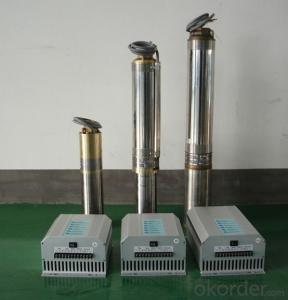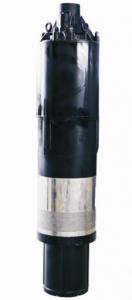Aquaponics Solar DC Solar Submersible Pumps
- Loading Port:
- China Main Port
- Payment Terms:
- TT OR LC
- Min Order Qty:
- -
- Supply Capability:
- -
OKorder Service Pledge
OKorder Financial Service
You Might Also Like
Item Description :
This superb new addition to our solar fountain range comes with a 10w solar panel,and a powerful fountain pump that is capable of producing fountains of up to 2m in height. As well as being easy to set up and use.Instruction manual is supplied for assembly and maintenance.
Solar Fountain Key Features :
Powered by direct sunlight
No high voltage electric mains required
Safe for children
Max. height of fountain: 2M
Max. flow capacity: 800 L/H(176 GAL)
10W Polycrystalline solar panel included
18V DC brushless pump
Solar Pump Features :
Can produce fountains up to : 2M (tube height) 1.4M (fountain height)
Comes with multiple nozzle accessories
Cable Length : 5M
Solar Panel Features :
10W peak power.
Polycrystalline highly efficient solar panel
Comes mounted in aluminium frame
Comes with ground stake and rotating knob so you can angle your panel toward the sun
What You Will Get :
10W solar panel
Solar pump
Ground Sake
Nozzle accessories
Precautions :
DO NOT alter or change the product itself or its components
Operate pump in freshwater only, never above 50 degrees celsius
Keep away from flammable liquids
Do not connect to any other power supply other than the included
- Q: Can a solar pump be used in areas with high levels of chlorides in the water?
- Yes, a solar pump can be used in areas with high levels of chlorides in the water. Chlorides do not affect the functionality or efficiency of the solar pump. However, it is important to regularly monitor and maintain the pump to prevent any potential corrosion or damage caused by the chlorides in the long run.
- Q: How does the cost of maintaining a solar pump compare to a traditional pump?
- The cost of maintaining a solar pump generally tends to be lower compared to a traditional pump. This is primarily due to the fact that solar pumps do not rely on electricity from the grid, which eliminates the need for expensive electrical connections and ongoing electricity bills. Solar pumps are powered by renewable energy from the sun, making them more cost-effective in the long run. In terms of maintenance, solar pumps have fewer moving parts compared to traditional pumps, which reduces the likelihood of mechanical failure and the need for frequent repairs. Additionally, solar pumps do not require fuel or oil changes, further reducing maintenance costs. Moreover, solar pumps have a longer lifespan compared to traditional pumps, typically lasting for 20-25 years or more. Traditional pumps, on the other hand, may need to be replaced or repaired more frequently, increasing the overall cost of maintenance. It is important to note that the initial installation cost of a solar pump may be higher than that of a traditional pump. However, considering the lower maintenance and operational costs over its lifespan, a solar pump often proves to be a more cost-effective and sustainable option in the long term.
- Q: Can a solar pump be used in areas with low water table?
- Yes, a solar pump can be used in areas with low water tables. However, it is important to note that the efficiency of the pump may be affected in such areas. A low water table means that the distance between the ground surface and the water source is greater, requiring the pump to work harder to extract water. Additionally, the amount of water that can be pumped may be limited in areas with low water tables.
- Q: Can a solar pump be used for water circulation in ponds?
- Yes, a solar pump can be used for water circulation in ponds. Solar pumps are designed to run on solar energy, making them a sustainable and eco-friendly option for pond circulation. They can help improve water quality by promoting oxygenation and preventing stagnation, benefiting the overall health of the pond ecosystem.
- Q: How do I choose the right size of solar pump for my needs?
- Choosing the right size of solar pump for your needs requires considering factors such as the water flow required, the depth and distance the pump needs to lift water, and the power output of the solar panels. It is important to calculate the total dynamic head (TDH) and select a pump that can meet that TDH, along with considering the desired water flow rate. Additionally, ensure that the power output of the solar panels is sufficient to run the pump effectively. Consulting with a solar pump expert or supplier can also provide valuable guidance in selecting the appropriate size for your specific needs.
- Q: Can a solar pump be used for water supply in zoos and wildlife sanctuaries?
- Yes, a solar pump can be used for water supply in zoos and wildlife sanctuaries. Solar pumps are an environmentally friendly and cost-effective solution for providing water in remote areas where electricity may not be readily available. They can be used to pump water from wells, rivers, or other water sources, ensuring a reliable water supply for the animals in zoos and wildlife sanctuaries while minimizing the impact on the ecosystem.
- Q: Can a solar pump be used in areas with strict emissions regulations?
- Yes, a solar pump can be used in areas with strict emissions regulations. Solar pumps operate using renewable energy, which means they do not produce any emissions or pollutants during their operation. This makes them an environmentally friendly solution that complies with strict emissions regulations.
- Q: Can solar pumps operate during cloudy days?
- Solar pumps can operate during cloudy days, but their efficiency may be reduced. The amount of power generated by the solar panels will be lower due to the reduced sunlight, resulting in a decrease in the pump's performance.
- Q: Can a solar pump be used in industrial applications?
- Yes, a solar pump can be used in industrial applications. Solar pumps can be used for various industrial purposes such as water supply, irrigation, wastewater treatment, and even in the oil and gas industry. They are particularly useful in remote areas where access to electricity is limited or expensive. Solar pumps are cost-effective, environmentally friendly, and have low maintenance requirements. Additionally, they can be integrated with other renewable energy systems such as solar panels or wind turbines to provide a reliable and sustainable source of power for industrial applications. Overall, solar pumps offer a viable solution for industrial water pumping needs while reducing reliance on fossil fuels.
- Q: Can a solar pump be used in conjunction with a battery backup system?
- Yes, a solar pump can be used in conjunction with a battery backup system. The solar panels will generate power during the day, which can be used to directly power the pump or charge the batteries. The battery backup system will store excess power generated by the solar panels, allowing the pump to continue operating during periods of low sunlight or at night.
Send your message to us
Aquaponics Solar DC Solar Submersible Pumps
- Loading Port:
- China Main Port
- Payment Terms:
- TT OR LC
- Min Order Qty:
- -
- Supply Capability:
- -
OKorder Service Pledge
OKorder Financial Service
Similar products
Hot products
Hot Searches
Related keywords
























